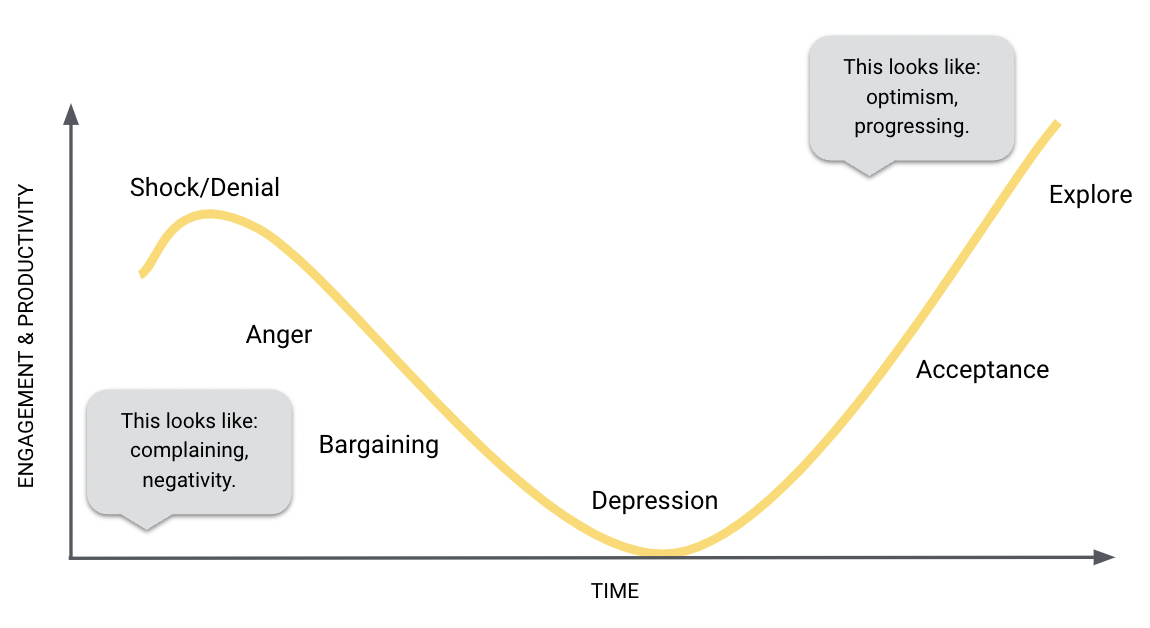Leading Through Change.
The more you communicate certainty, the better.
Why do people process change differently?
How quickly someone moves through change is influenced by five factors.
The severity of the change.
For example, is it a small change like their coffee order, or is it a larger change, like getting a new boss?
How much mental space they’ve got to take on new information.
For example, do they have space to think about what it means, or are they all out of decision making power for the week?
How much emotional reserve they have in the bank.
For example, have they ‘spent’ their caring credits on family, kids, partner, boss already, or do they have a few left to think about how to look after themselves during this change?
How they generally perceive what’s in their control.
Their change resilience, commonly called ‘locus of control’: whether they believe change happens ‘to them’ vs ‘around them’.
How they’re typically wired.
We gravitate to what we’re used to, right? Their nervous system will always crave a ‘familiar hell’ over an ‘unfamiliar heaven’, because it’s certain.
This then becomes a ‘baseline’ for what happens next.
The two stages of change.
This is the Kübler-Ross Change Model accredited to psychiatrist Elisabeth Kübler-Ross.
In the shock phase, your team members are processing five potential threats:
Security: Is my job safe? Can I still make money?
Competence: Am I still good at my job? Is this a new thing?
Autonomy: Do I have a choice? Can I still choose what I want to do?
Relatedness: What will other people think of me? Who else knows?
Fairness: Is this fair? Is this happening to other people or just me?
The behaviour is different for each person, but the thought process is the same: what does this change mean for me?
Pictured: a curve with two axes. On the left is the change severity, from low to high. On the right hand axis is time. There is a curve starting with the stage ‘shock’. The curve goes down, indicating someone is processing the change. The curve then returns upwards towards acceptance indicating positive action.
If your people are defensive, they’ve received the message.
While it’s not nice to be on the receiving end of, it’s not personal. It’s the biology of managing change. They are simply wondering: what does this all mean for me?
When people stay in shock too long, they get stuck in ‘change limbo’.
They’re on an island, feeling overwhelmed and stuck.
They have accepted the change has happened, but don’t have the energy or confidence to take a step forward. In this stage, their brain is telling them it’s too hard. This is when your people need extra support.
Four signs your people are stuck in change limbo.
It’s been more than 8 months.
Research shows habits take anywhere between 2-8 months to stick. Because we go through the stages of change at different rates, there’s no ‘normal’ timeline. But it’s a handy guide to figure out when to adapt your feedback to what you’re noticing.
They’re more tired than usual.
While it’s natural to feel wiped by change, when people experience lots of change in a small amount of time, they experience ‘change fatigue’. They’ll need extra rest and support during this time. Keep an eye on their energy levels and adjust your expectations of what’s possible during this time.
They feel incompetent and uncertain.
The cost of experiencing anything new is feeling temporarily incompetent. They won’t like this feeling. As a result, they’ll probably act up a bit like a toddler having a tantrum.
All feelings are okay. But it’s not okay to act up at work. Help them find an outlet (e.g. EAP, counselling, a coach, a mentor).
They create an enemy.
When we’re overwhelmed, we look for someone to blame. E.g. ‘It’s not fair, this restructure is happening to me.’ Their brain is attempting to make them safe by creating a common enemy.
Teach them that there are no ‘baddies’, just as there are no ‘goodies’. There is a change, and there is how you respond to it.
As a leader, your job is to remind them that change is happening ‘around them’ vs ‘to them’.
Specifically, to help them remember they have choice, agency and possibilities.
To do this, you can:
Provide certainty (as below).
Remind people what is within their control vs out of their control.
Give them support and space.
The quick script for communicating change.
Be explicit, own what you don’t know, and over communicate.
Start with communicating:
What you know for sure in this change. Specifically, what is definitely changing? What is not changing?
What you don’t know yet. What is not clear to you yet? What don’t you know yet? Be explicit about what you don’t know yet. Be explicit that once you do know, you’ll share that.
What does this mean for your/their role? Be explicit about how this impacts their role in three areas: their options, expertise and relationships.
What will definitely change and definitely won't? Be explicit about what will change. This helps people focus on the most useful things to mentally process.
Something to think about today.
If a big change happened tomorrow … do your colleagues or leaders have a script to communicate change?
Do they have a toolkit to help them feel prepared to handle it?
Do you?



